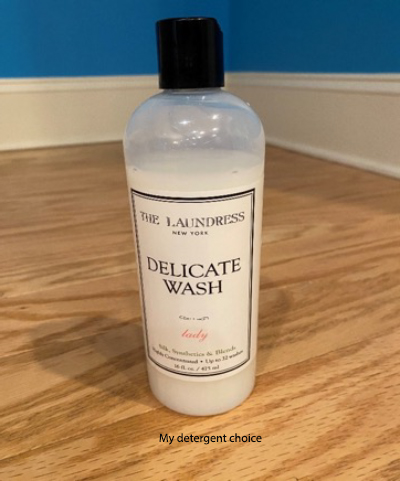“From the Archives – Formaldehyde in Baby Shampoo” talks about Johnson and Johnson removing Quaternium-15, a preservative, from its baby shampoo because it decomposed to formaldehyde. Even though there was absolutely no risk from the extremely low concentrations of formaldehyde in the shampoo, it was easier to remove Quaternium-15 and replace it with other preservatives than endure the senseless attacks by the Environmental Working Group and others claiming Johnson and Johnson’s products to be harmful to children.
Last year when I realized that the mask mandate was not going away any time soon, I went online and ordered specialized laundry detergent to wash my masks. I used it for a few months and then completely forgot about it until last week when I received a recall notice from the Consumer Product Safety Commission (CPSC). My laundry detergent had been recalled because of contamination with multiple harmful bacteria, including Burkholderia cepacia complex, Klebsiella aerogenes, and multiple species of Pseudomonas. I had unknowingly bought a preservative-free laundry product. I would have been tipped off if I had looked at the back of the bottle, which touted it as a natural product, “free of petroleum, phosphate, phthalates, and artificial color.”

Formaldehyde
Formaldehyde is a naturally occurring substance present throughout the environment. Humans create about 1.5 ounces of formaldehyde a day as part of our normal metabolism and inhale about 0.0007 ounces, which is converted to carbon dioxide and exhaled naturally from our lungs. Formaldehyde is present in fish (6,800 parts per billion (ppb)), apples (6,300 ppb), and coffee (3,400 ppb).
At low concentrations of formaldehyde (less than 40 ppb), no adverse effects are expected; at moderate concentrations (above 40 ppb), there may be respiratory symptoms, including coughing, wheezing, and with long-term exposure difficulty breathing. At high concentrations (above 100 ppb), these symptoms worsen. A rare type of cancer (nasopharyngeal cancer) has been associated with industrial, workplace exposure to very high concentrations of formaldehyde over long periods of time.
Most problems with formaldehyde exposure occur inside our homes. It may be released from carpets, furniture, flooring, or burning materials such as cigarettes, fireplace smoke, or vehicle exhaust infiltrating the house. Many people became aware of formaldehyde after the widespread coverage of the Federal Emergency Management Agency (FEMA) trailers used to house survivors of Hurricane Katrina.
In 2005, at least 145,000 trailers were bought by FEMA to house people who lost their homes in Hurricane Katrina. In 2006, reports of health problems, including breathing difficulties, eye irritation, flu-like symptoms, and nosebleeds, began appearing in the press. A government report issued that year identified moderate levels of formaldehyde in the trailers, averaging about 77 parts per billion (ppb), as the responsible agent.
This highlights one of the most challenging concepts to understand “The dose makes the poison.” A minuscule amount of a chemical, whether in a preservative, consumer product, air, or water, does not have the same effect as a very high chemical concentration.
“Any suggestion that formaldehyde in shampoo presents a cancer risk is unfounded. Actually, mommy’s breath may be a greater risk.”
-Joe Schwarcz, Director of the McGill University Office for Science and Society
Returning to Johnson and Johnson baby shampoo, one researcher calculated the amount of formaldehyde released from Quaternium-15 in baby shampoo in a bathroom at 0.2 milligrams per cubic meter (mg/cm3) of air, less than the amount typically found in human breath (0.4 mg/m3).
Why Preservatives Should be Celebrated
As the time between the manufacture of a consumer product and its purchase and use increases, there is an opportunity for microbial overgrowth. Preservatives prevent that growth. Components in consumer products that allow bacteria to grow include:
- water
- vegetable oils
- waxes and butters
- most surfactants
- proteins and amino acids
- herbal extracts
We only need to look back to 2012 in Framingham, Massachusetts, to demonstrate what can happen when preservatives are not used. The New England Compound Center created a preservative-free methylprednisone, a medication used for epidural steroid injections. Three lots were contaminated with fungus, resulting in more than 100 deaths and 798 individuals contracting fungal meningitis.
Many preservatives have been used safely for years and are now widely referred to in the media as unsafe and dangerous to human health.
The following are some of the main preservatives used in consumer products:
- Parabens
- Formaldehyde and formaldehyde donors included Quaternium-15
- Triclosan
- Methylchloroisothiazolinone/Methylisothiazolinone (MCI/MI)
- Phenoxyethanol
- Benzoic acid
- Sorbic acid
- Ethanol
- Glycerin
- Benzyl alcohol
There are a few “natural” preservatives, such as phenyl ethyl alcohol, ethyl lauroyl, and silver compounds, which in some cases can be used as alternatives to the above substances. However, most of these cannot be used in strong enough concentrations to fight contamination without causing skin irritation or allergic reactions.
In 2020, the State of California became the first State in the U. S. to ban 24 ingredients from cosmetics and personal care products, including the preservative formaldehyde, Quaternium-15, and several parabens.
This presents a real danger to public health as the availability of safe and effective preservatives is reduced, resulting in the increased use of ineffective or inadequately tested alternatives and an increased risk of serious bacterial outbreaks.
We will continue to get policy wrong and create fear in the public until the media and consumer groups distinguish between the effects of trace amounts of chemicals and high concentrations from long-term exposure. Preservatives should be recognized as an essential part of a product, whether in laundry detergent, baby shampoo, or any other consumer product.





